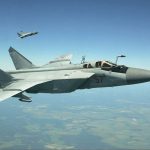
Provocation in Estonia: Kremlin’s Games and NATO’s Patience

As expected, yesterday brought an inevitable step. It fits the escalation theory that Pootin follows like clockwork. After the drone raid on Poland and the weak reaction from both Poland and NATO, he had to raise the heat. The only question was how, where, and with what force. Now we have the answer. This time, the signal came through a provocation in Estonia — a small move on the map, but a loud message meant to test NATO’s resolve.
On September 19th, three MiG-31 fighters simultaneously entered Estonian airspace and remained there for 12 minutes. These were not MiG-31K bombers with “Kinzhal” missiles but interceptors. Their purpose is to intercept high-speed, high-altitude targets, which means they should operate over their own territory in support of air defense, and they generally have no assignments outside it.
Perfect Tool for a Provocation
That aircraft fits provocations perfectly. In fact, the aircraft are ideal for that. Currently, it is the fastest serial fighter in service worldwide. At high altitudes, it can reach speeds of 3,100 km/h, or Mach 2.8. At lower altitudes, in denser air, its speed is roughly half. Reports do not specify the flight altitude, but one can easily calculate the distance covered in 12 minutes at such speeds.
It was a pure provocation, given that three fighters flew together, leaving no room for accidental interpretation. Clearly, the objective mirrored that of the two dozen drones over Poland – to observe the performance of air defense systems in the area and to test the decisiveness of potential responses. It is unclear how much intelligence they gathered on radar locations, operational methods, or other details, but they certainly tested the decisiveness of reactions – and found none.
NATO Fails Again
Logic dictates that any violation of airspace by foreign, let alone combat, aircraft already justifies the use of force. Moreover, according to open sources, the aircraft had their transponders off and did not respond to air traffic control. This was not just a provocation in Estonia — it was a textbook hostile intrusion. NATO, however, once again failed to respond effectively.
We can also infer that the recent exercises in Belarus were aimed at simulating strikes along the Suwałki corridor. Most likely, this scenario is part of a much larger operational plan to seize the entire Baltic region. If so, this maneuver may pave the way for a land corridor toward Kaliningrad, allowing strikes in opposing directions. But who said this is where they plan to start the full execution?
Estonia lies at the very “corner” of the southern Baltic, and its territory appears most vulnerable both geographically and in terms of troop strength. Considering Russian logic, one can imagine how events might unfold and how the sequence of actions could be planned if war broke out on the Baltic flank.
Provocation in Estonia and Orcs’ Logic
Assume that on October 1st, Russian forces begin an advance across the Estonian border. Troops there are few and can be dealt with using air and drone power before the land phase even begins. Even entering Estonian airspace is unlikely to provoke active resistance. As we know from experience, border regions can be targeted with precision-guided munitions without entering enemy airspace. NATO would start redeploying forces in response, but how? By sea, the challenge of air opposition arises, with Russian aviation difficult to counter.
The most reliable method of troop transfer would likely be overland, raising the question of the Suwałki corridor. Everyone knows how vulnerable large equipment columns are. NATO is aware that the adversary can threaten flanks from Kaliningrad and Belarus, making them think twice about moving forces along that route. Russian threats alone could sufficiently slow reinforcement deployment to Estonia, buying the invaders precious time.
Baltic forces and small NATO units in place are meant to slow the orcs, not stop them. This raises the question of timing for reinforcements and whether the existing forces can resist the onslaught long enough. NATO may still be scrambling to decide whether to use the corridor, by which time the situation could already shift drastically. If Latvia and Lithuania’s defenses collapse, there may be no need to activate a Suwałki operation – the occupiers could secure the corridor from the east, completing their objective.
Gathering Intel, Preparing Moves
All of the above are hypotheses, as we cannot look into orcs brain. All of this may sound like speculation, but the pattern is clear. This is not random mischief. This is the initial phase of executing an operational plan. Active collection of applied data is underway – examining how and with what means the adversary could resist, and most importantly, how prepared they are to oppose both on a national and alliance-wide scale.
Now, looking at the drone attack in Poland and this provocation in Estonia, and considering our experience over more than three and a half years of war, everyone can try to guess what answers the Russians received. I must note that I sincerely hope I am wrong in my assumptions, but in January – February 2022, I too hoped for the same outcome.
Related posts:


How to stop Russian provocations in Europe: What Must Be Done
Russia is tearing NATO apart without firing a single decisive strike. Russian drones show up in Denmark, Norway, and the Netherlands. MiGs buzz through Estonia’s airspace. Russian planes [...]
Are There Effective Medicine for Russian Provocations?
Everyone surely remembers how the era of hybrid wars began. The enemy executed things either through other hands or flatly refused to take responsibility. They called the perpetrators [...]